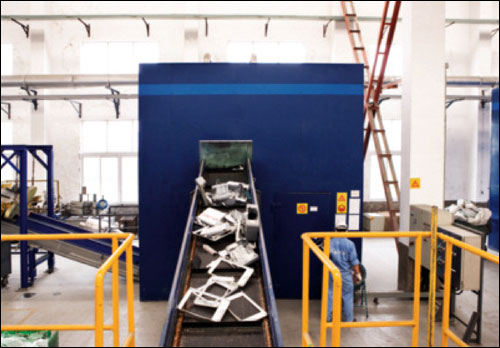Jun 01, 2012Electronics manufacturers that implement green strategies for recycling their products, so potentially toxic components don't end up in landfills, can have a huge impact on the environment and people's health. That's a message Hewlett-Packard (HP) has taken to heart. The company's corporate-wide commitment to recycling and reuse has led the manufacturer to recover more than 2.3 billion pounds of products since 1987.
To do its part, HP Brazil, in 2009, set up drop-off centers around the country, where customers could return ink-jet printers for recycling. The following year, it established the SmartWaste project, to leverage the RFID infrastructure it deployed to track printers using passive ultrahigh-frequency tags with Electronic Product Codes (HP Brazil won the 2007 RFID Journal Award for Best Implementation for tracking printers through production and distribution; see Keeping Tabs on Printers). The goal was to use the tag information to manage reverse logistics for end-of-life products. "We realized we had enough tagged printers in the market to use them," says Marcelo Pandini, HP Brazil's country operations manager.

The forward-thinking company also believed the RFID-based recycling program would support compliance with the Brazilian government's National Solid Waste Policy (PNRS) legislation, enacted in August 2010, which makes electronics manufacturers responsible for collecting products and packages that can be reused. Brazilian officials estimate it will take four years until the legislation is enforced, and there are no mandates about what technology, if any, should be used to control the process, Pandini says. But thanks to RFID, HP Brazil is prepared to share recycling information with the government. "I think using a standard like EPC that already exists and is controlled by a nonprofit like GS1 could be one good option [for managing the recycling program]," he says.
Meanwhile, HP Brazil has been taking advantage of the valuable tag information on each printer. From July 2011, when the company implemented the SmartWaste solution, to the end of February 2012, it has collected 35 tons of plastics for reuse. The EPC and serial numbers on each tag link to a database with a wealth of information about each printer, including its recyclable materials, the majority of which are acrylonitrile butadiene styrene (ABS) and high-impact polystyrene (HIP) plastics.
"Our principle in recycling is to reintroduce such material into our supply chain again," for use in new printer products, Pandini says. "To do that, we need more information control about what comes back with what we are recycling."
Working With a Non-RFID Partner
The SmartWaste project was a one-year effort, with the first six months focused on design and planning at HP's RFID Center for Excellence, in São Paulo, and the last six months on the pilot and implementation at the Oxil recycling center, an HP partner, in Paulinia-São Paulo. HP Brazil didn't have employees stationed at the recycling center to monitor the process, and didn't want to interfere with the recycling operation or add requirements. But because the printers were already tagged, the company's cross-functional team was able to develop a system to read the tags at the recycling center and transmit the data to the manufacturer.
The printers are collected from drop-off centers and sent on pallets to the Oxil recycling facility, where they are depalletized. Before the printers move onto the disassembly line, where parts are separated manually by type of materials, such as plastic, metals, paper and electronic components, the RFID tags are interrogated by Mercury5 readers from ThingMagic (a division of Trimble). The plant's conditions are very different from the clean, humidity-controlled environment of the manufacturing floor, Pandini says. What's more, the printers are old and often dirty, contributing to a dusty environment.
"When we are talking about a regular manufacture operation, you can maintain and keep RFID or any equipment working," Pandini says, noting that on-site technicians and engineers are typically available to intervene if a problem arises. "When you go to a recycling center, it's a totally different story. There are fewer resources, technical expertise is reduced because nobody wants to put too much cost into this kind of operation—there's a different perspective of disassembling a used old product vs. building a brand new one."
To meet the environmental challenges, HP Brazil secured the Mercury5 readers in locked, steel-enclosed cases, and reinforced the readers' antennas to keep them dust-free. Additionally, it provided recycling center personnel with simplified instructions for making minor adjustments if necessary.
Oxil takes control over whatever recyclable components HP Brazil determines it does not need for reinsertion into new printer products. "Controls are in place to make sure that proper disposal is part of the agreement of what we don't take back for our own usage," Pandini says. "Our partner has to do everything according to the laws and regulatory agreements."
Smart Business
The environmental business strategic team can view customized information on dashboards, to assess the amount of materials recovered. On-screen graphs, for example, can show the amount of each material recycled, including ABS, HIPS and metals and the number of products recycled per month. The information helps forecast how much recycling material is available for production. Up to 40 percent of the materials in the company's new products is recycled from old printers, Pandini says.
But multiple reuses of recycled materials could present a challenge down the road, when printers that already include recycled materials are returned. The EPC data on the tag will identify these printers and provide information HP Brazil can use to determine which plastics can be reused again and which will need to undergo some adjustment process or be disposed of properly. "The issue, technically speaking, is there is a challenge in terms of material, its constitution and the preservation of engineering properties of a particular plastic," Pandini says. "Today, that's not impacted, because it's just one or two recycles. But that will change." HP Brazil has research and development efforts under way to create formulas for segregating and reusing the different types of plastics in its printers multiple times.
"The great part is that RFID tags are still alive from five to six years ago," Pandini says. "You take a read and the information is there. This just proves that the technology can be used for the whole cycle of a product's life, not just to control the beginning—the supply chain of producing and shipping to customers—but to help manage taking back recyclable materials."


